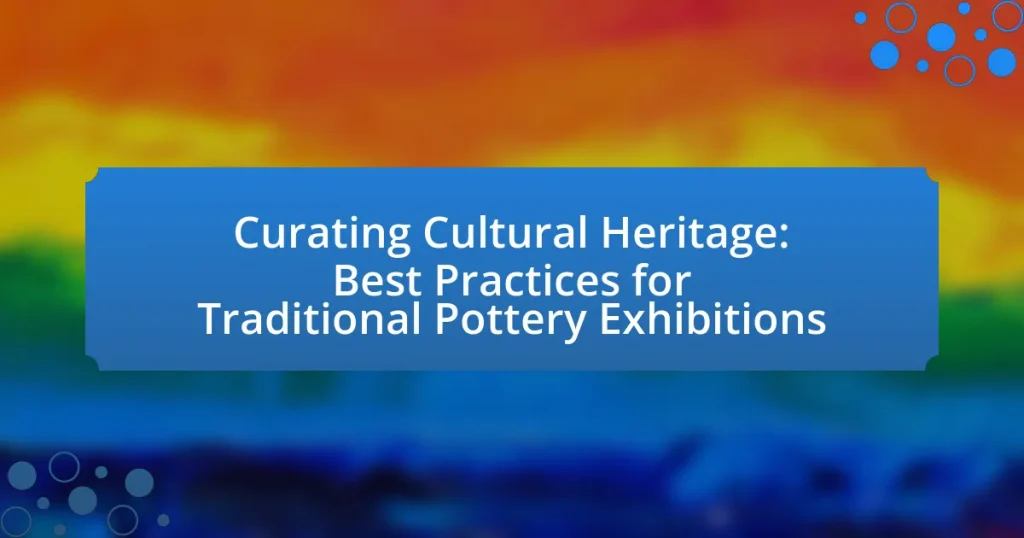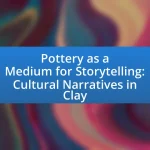Curating cultural heritage in traditional pottery exhibitions involves the systematic selection and presentation of pottery artifacts to highlight their historical, artistic, and cultural significance. The article outlines best practices for curating these exhibitions, emphasizing the importance of thorough research, contextual storytelling, and audience engagement. Key elements discussed include the significance of traditional techniques, regional styles, and cultural narratives that shape the understanding of pottery. Additionally, the article addresses challenges such as sourcing authentic pieces and ensuring proper preservation, while also exploring the role of technology and social media in enhancing visitor experiences and promoting exhibitions.
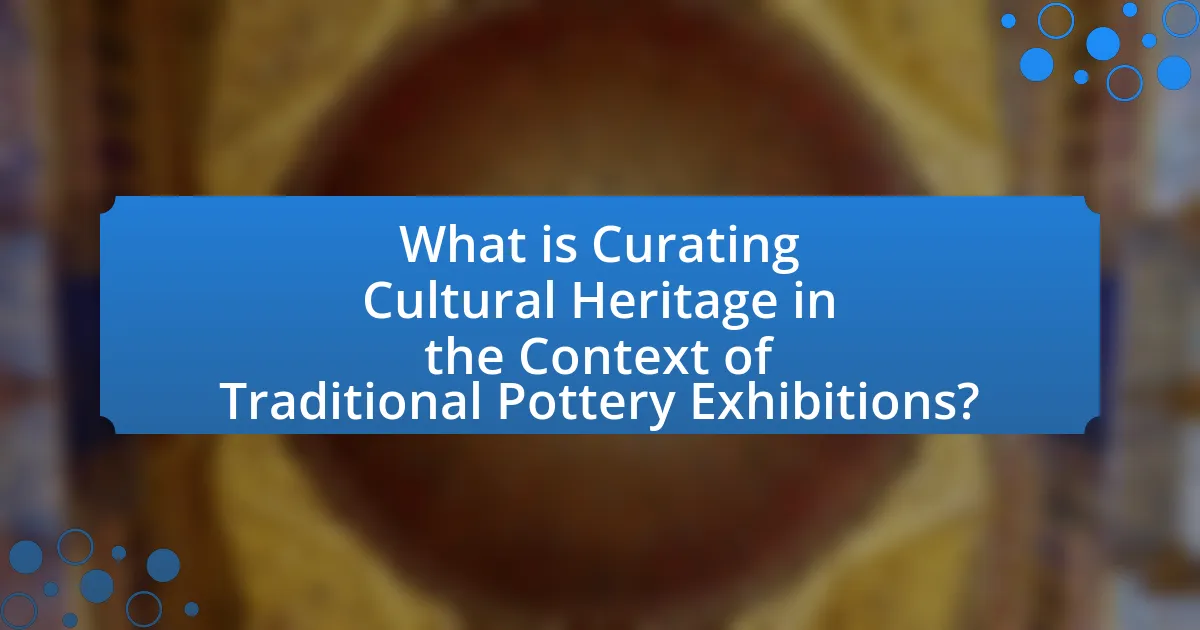
What is Curating Cultural Heritage in the Context of Traditional Pottery Exhibitions?
Curating cultural heritage in the context of traditional pottery exhibitions involves the systematic selection, organization, and presentation of pottery artifacts to convey their historical, artistic, and cultural significance. This process includes researching the origins, techniques, and cultural contexts of the pottery, ensuring that the exhibition accurately represents the traditions and practices of the communities from which the pottery originates. For instance, curators may draw upon anthropological studies and historical records to highlight the craftsmanship and cultural narratives associated with specific pottery styles, thereby fostering a deeper understanding and appreciation among audiences.
How does curating cultural heritage enhance the understanding of traditional pottery?
Curating cultural heritage enhances the understanding of traditional pottery by providing contextual frameworks that highlight its historical, social, and artistic significance. This curation process involves the careful selection and presentation of artifacts, which allows audiences to appreciate the craftsmanship, cultural narratives, and regional variations inherent in traditional pottery. For instance, exhibitions that include detailed descriptions of the pottery’s origins, usage, and the techniques employed by artisans facilitate a deeper connection between viewers and the cultural practices surrounding these objects. Furthermore, research indicates that immersive experiences, such as interactive displays and workshops, can significantly increase engagement and comprehension, as evidenced by studies conducted in various museums that show enhanced visitor learning outcomes when cultural heritage is effectively curated.
What are the key elements of cultural heritage in pottery?
The key elements of cultural heritage in pottery include traditional techniques, regional styles, symbolic motifs, and historical context. Traditional techniques refer to the methods passed down through generations, such as hand-building or wheel-throwing, which reflect the craftsmanship of a culture. Regional styles encompass the unique characteristics of pottery from specific areas, showcasing local materials and aesthetic preferences. Symbolic motifs often represent cultural beliefs, stories, or values, serving as a visual language that connects the pottery to its cultural roots. Historical context provides insight into the societal, economic, and environmental factors that influenced pottery production, highlighting its role in daily life and rituals. These elements collectively contribute to the understanding and appreciation of pottery as a vital aspect of cultural heritage.
How do cultural narratives influence pottery exhibitions?
Cultural narratives significantly influence pottery exhibitions by shaping the themes, presentation, and interpretation of the artworks displayed. These narratives provide context that connects the pottery to the cultural, historical, and social backgrounds from which they originate, allowing viewers to understand the significance of the pieces beyond their aesthetic value. For instance, exhibitions often highlight specific cultural stories, traditions, or practices associated with pottery, such as the role of ceramics in rituals or daily life within a community. This contextualization is supported by research indicating that cultural narratives enhance audience engagement and appreciation, as seen in exhibitions that focus on indigenous pottery, which often include storytelling elements that reflect the community’s heritage and values.
Why is traditional pottery significant in cultural heritage?
Traditional pottery is significant in cultural heritage because it embodies the artistic expression, historical practices, and social values of a community. This form of craftsmanship reflects the unique identity and traditions of various cultures, often passed down through generations. For instance, the techniques and designs used in traditional pottery can reveal insights into the daily lives, rituals, and beliefs of the people who created them, such as the use of specific motifs that symbolize fertility or prosperity. Additionally, UNESCO recognizes traditional pottery as an important aspect of intangible cultural heritage, highlighting its role in fostering community cohesion and continuity.
What historical contexts shape traditional pottery practices?
Traditional pottery practices are shaped by various historical contexts, including cultural, economic, and technological influences. For instance, ancient civilizations such as the Mesopotamians and Egyptians developed pottery techniques that reflected their societal needs, such as storage and cooking, which were crucial for their agricultural economies. Additionally, the introduction of the potter’s wheel in the 4th millennium BCE revolutionized pottery production, allowing for more uniform shapes and greater efficiency. Archaeological findings, such as those from the Indus Valley Civilization, demonstrate how pottery styles evolved in response to trade interactions and cultural exchanges, influencing local practices and aesthetics. These historical contexts provide a framework for understanding the significance of traditional pottery within cultural heritage.
How does traditional pottery reflect cultural identity?
Traditional pottery reflects cultural identity by embodying the values, beliefs, and historical narratives of a community. The designs, materials, and techniques used in pottery often originate from specific cultural practices and environmental resources, showcasing the unique heritage of a group. For instance, Native American pottery frequently incorporates symbols and motifs that represent spiritual beliefs and community stories, while Japanese ceramics emphasize aesthetics and craftsmanship rooted in Zen philosophy. These elements serve as tangible expressions of cultural identity, allowing communities to communicate their history and traditions through their pottery.
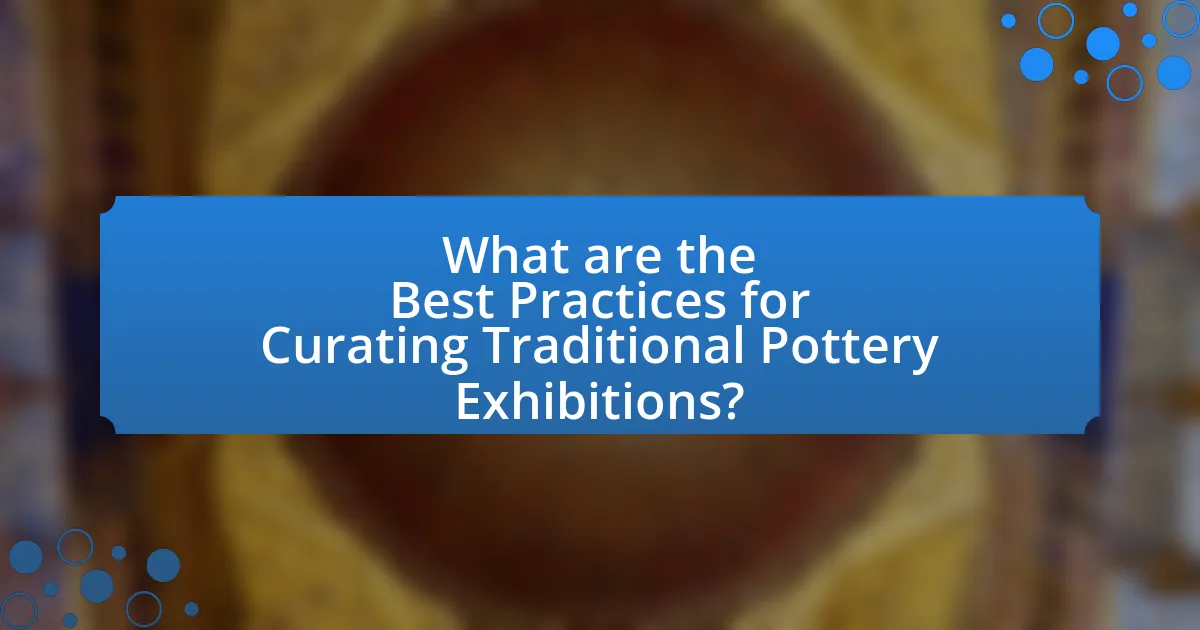
What are the Best Practices for Curating Traditional Pottery Exhibitions?
The best practices for curating traditional pottery exhibitions include thorough research, contextual storytelling, and audience engagement. Curators should conduct extensive research on the historical and cultural significance of the pottery to ensure accurate representation. Contextual storytelling enhances the visitor experience by connecting the artifacts to their cultural origins, which can be supported by scholarly sources such as “The Role of Context in Museum Exhibitions” by Susan M. Pearce, highlighting the importance of narrative in exhibitions. Additionally, engaging the audience through interactive displays or educational programs fosters a deeper understanding and appreciation of the pottery, as evidenced by studies showing increased visitor satisfaction and retention of information when interactive elements are included.
How can curators effectively select pottery pieces for exhibitions?
Curators can effectively select pottery pieces for exhibitions by establishing clear criteria based on artistic significance, historical context, and cultural relevance. This involves assessing the craftsmanship, style, and provenance of each piece to ensure it aligns with the exhibition’s theme and objectives. For instance, curators may prioritize works that represent key cultural narratives or showcase innovative techniques, thereby enhancing the educational value of the exhibition. Additionally, curators can utilize existing collections, scholarly research, and expert consultations to validate their selections, ensuring a well-rounded representation of the pottery’s cultural heritage.
What criteria should be used for selecting traditional pottery?
The criteria for selecting traditional pottery include authenticity, craftsmanship, cultural significance, and condition. Authenticity ensures that the pottery is genuinely representative of its cultural origin, while craftsmanship reflects the skill and techniques used by the artisans. Cultural significance assesses the pottery’s role in the community’s traditions and practices, and condition evaluates the physical state of the pottery, including any repairs or alterations. These criteria are essential for preserving cultural heritage and ensuring that exhibitions accurately represent the traditions they aim to showcase.
How does the provenance of pottery influence selection?
The provenance of pottery significantly influences selection by providing essential information about its origin, historical context, and cultural significance. This information helps curators assess the authenticity and value of the pottery, guiding decisions on which pieces to include in exhibitions. For example, pottery from well-documented archaeological sites or recognized cultural traditions is often prioritized due to its established historical relevance and connection to specific communities. Provenance also aids in understanding the techniques and materials used, which can enhance the educational value of the exhibition.
What strategies can enhance visitor engagement in pottery exhibitions?
Interactive workshops can significantly enhance visitor engagement in pottery exhibitions. By allowing attendees to participate in hands-on activities, such as creating their own pottery pieces, exhibitions foster a deeper connection to the art form. Research indicates that interactive experiences increase retention and satisfaction; for instance, a study by the American Alliance of Museums found that 80% of participants in interactive exhibits reported a higher level of enjoyment compared to traditional displays. Additionally, incorporating storytelling elements about the history and cultural significance of pottery can captivate visitors, making the experience more memorable.
How can interactive elements be integrated into exhibitions?
Interactive elements can be integrated into exhibitions by incorporating hands-on activities, digital interfaces, and immersive experiences that engage visitors. For example, touchscreens can provide information about traditional pottery techniques, while augmented reality applications can allow visitors to visualize the pottery’s historical context. Research indicates that interactive exhibits enhance visitor engagement and retention of information, as evidenced by a study conducted by the American Alliance of Museums, which found that 70% of visitors reported a deeper understanding of the subject matter when interactive elements were present.
What role do educational programs play in enhancing visitor experience?
Educational programs significantly enhance visitor experience by providing context, knowledge, and engagement opportunities related to traditional pottery. These programs facilitate deeper understanding of cultural heritage, allowing visitors to appreciate the historical and artistic significance of the exhibits. For instance, hands-on workshops and guided tours can increase visitor interaction and retention of information, as evidenced by studies showing that interactive learning experiences lead to higher satisfaction rates among museum-goers. Additionally, educational programs often include expert talks or demonstrations, which can enrich the visitor’s connection to the art form and its cultural background, ultimately fostering a more meaningful and memorable experience.
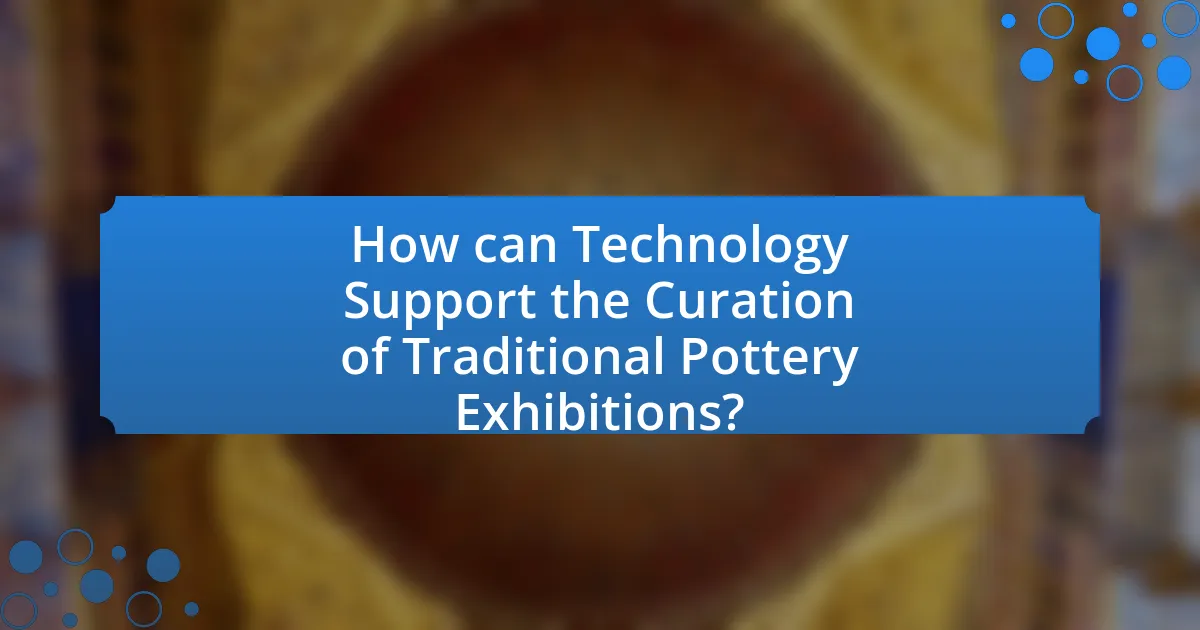
How can Technology Support the Curation of Traditional Pottery Exhibitions?
Technology can support the curation of traditional pottery exhibitions by enhancing the presentation, accessibility, and educational value of the artifacts. Digital tools such as 3D modeling and virtual reality allow curators to create immersive experiences that showcase pottery in a detailed and interactive manner, enabling visitors to explore the craftsmanship and historical context of each piece. For instance, the use of augmented reality applications can provide additional information about the pottery’s origin, techniques, and cultural significance, enriching the visitor’s understanding. Furthermore, online platforms facilitate broader access to exhibitions, allowing audiences worldwide to engage with traditional pottery collections remotely. This approach not only preserves cultural heritage but also promotes global appreciation and awareness of traditional pottery practices.
What digital tools are available for curating pottery exhibitions?
Digital tools available for curating pottery exhibitions include software for collection management, virtual exhibition platforms, and digital asset management systems. Collection management software like PastPerfect and TMS (The Museum System) allows curators to catalog and manage pottery artifacts efficiently. Virtual exhibition platforms such as Artsteps and Kunstmatrix enable the creation of immersive online exhibitions, allowing wider audience access. Digital asset management systems like Canto help organize and store high-quality images and metadata of pottery pieces, facilitating easy retrieval and sharing. These tools enhance the curation process by improving organization, accessibility, and presentation of pottery collections.
How can virtual reality enhance the exhibition experience?
Virtual reality can enhance the exhibition experience by providing immersive and interactive environments that allow visitors to engage with traditional pottery in a more meaningful way. This technology enables users to explore 3D models of artifacts, view them from multiple angles, and even simulate their historical context, which deepens understanding and appreciation. Research indicates that immersive experiences can increase retention of information by up to 75%, compared to traditional viewing methods. By integrating virtual reality, exhibitions can create a dynamic learning environment that fosters greater visitor engagement and educational outcomes.
What are the benefits of using augmented reality in pottery displays?
The benefits of using augmented reality in pottery displays include enhanced visitor engagement, improved educational experiences, and increased accessibility to cultural heritage. Augmented reality allows visitors to interact with pottery in a dynamic way, such as visualizing historical contexts or seeing 3D models of artifacts, which can significantly enhance their understanding and appreciation of the art form. Research indicates that interactive technologies like augmented reality can increase retention of information by up to 75%, making the learning experience more impactful. Additionally, augmented reality can provide access to detailed information about pottery techniques and cultural significance, which may not be possible in traditional displays, thus broadening the audience’s understanding and appreciation of pottery as a cultural heritage.
How can social media be leveraged to promote pottery exhibitions?
Social media can be leveraged to promote pottery exhibitions by creating engaging content that showcases the artistry and craftsmanship of the pottery. Platforms like Instagram and Facebook allow for visual storytelling, where high-quality images and videos of the pottery can attract potential visitors. Additionally, using targeted advertising on these platforms can reach specific demographics interested in art and culture, increasing visibility.
For instance, a study by the Pew Research Center indicates that 69% of adults in the U.S. use social media, making it a powerful tool for outreach. Engaging with followers through live demonstrations, behind-the-scenes content, and interactive posts can further enhance community interest and participation in the exhibition.
What strategies can curators use to engage audiences on social media?
Curators can engage audiences on social media by utilizing interactive content, storytelling, and community involvement. Interactive content, such as polls and quizzes, encourages audience participation and fosters a sense of connection. Storytelling about the cultural significance of traditional pottery can captivate audiences, making the content relatable and memorable. Additionally, involving the community through user-generated content or collaborations with local artists can enhance engagement and create a shared sense of ownership over the cultural heritage being presented. These strategies are supported by studies indicating that interactive and community-focused approaches significantly increase audience engagement on social media platforms.
How does online marketing impact attendance at pottery exhibitions?
Online marketing significantly increases attendance at pottery exhibitions by enhancing visibility and engagement with potential attendees. Digital platforms such as social media, email campaigns, and targeted advertisements allow organizers to reach a broader audience, including those who may not have been aware of the exhibition. For instance, a study by the National Endowment for the Arts found that 72% of arts attendees reported discovering events through online channels. This demonstrates that effective online marketing strategies can lead to higher turnout at pottery exhibitions by attracting diverse audiences and fostering community interest.
What are the common challenges faced in curating traditional pottery exhibitions?
Common challenges faced in curating traditional pottery exhibitions include sourcing authentic pieces, ensuring proper preservation, and engaging diverse audiences. Sourcing authentic pieces can be difficult due to the limited availability of traditional pottery and the need for verification of provenance. Proper preservation is crucial, as pottery is often fragile and susceptible to damage from environmental factors, requiring specialized display techniques and materials. Engaging diverse audiences poses a challenge as curators must create educational content that resonates with various cultural backgrounds and interests, ensuring accessibility and relevance. These challenges are supported by the need for curators to balance aesthetic presentation with educational value, as highlighted in studies on museum practices.
How can curators address issues of cultural appropriation?
Curators can address issues of cultural appropriation by actively engaging with the communities whose cultures are represented in exhibitions. This engagement includes consulting with cultural representatives to ensure accurate representation and context of the artifacts displayed. For instance, the American Alliance of Museums emphasizes the importance of collaboration with Indigenous communities to honor their cultural narratives and practices. By incorporating these perspectives, curators can create exhibitions that respect cultural ownership and promote understanding, thereby reducing the risk of appropriation.
What strategies can be implemented to overcome funding limitations?
To overcome funding limitations for traditional pottery exhibitions, organizations can implement strategies such as diversifying funding sources, establishing partnerships, and leveraging community engagement. Diversifying funding sources involves seeking grants from arts and culture foundations, applying for government funding, and exploring crowdfunding platforms, which can collectively provide a broader financial base. Establishing partnerships with local businesses and cultural institutions can lead to sponsorship opportunities and shared resources, enhancing the exhibition’s reach and impact. Additionally, engaging the community through workshops, events, and volunteer programs can foster local support and increase attendance, which may lead to additional revenue through ticket sales and donations. These strategies have been successfully employed by various cultural organizations, demonstrating their effectiveness in addressing funding challenges.
What are the key takeaways for successful curating of traditional pottery exhibitions?
Successful curating of traditional pottery exhibitions requires a deep understanding of the cultural significance of the artifacts, careful selection of pieces, and effective storytelling. Curators should prioritize the historical context and craftsmanship of the pottery, ensuring that each piece is representative of its cultural origins. Engaging narratives that connect the audience to the traditions and techniques behind the pottery enhance the exhibition’s impact. Additionally, incorporating interactive elements and educational programs can foster a deeper appreciation among visitors. Research indicates that exhibitions that provide context and engage audiences through storytelling lead to higher visitor satisfaction and retention of information.
How can curators ensure the authenticity of the pottery displayed?
Curators can ensure the authenticity of the pottery displayed by conducting thorough provenance research and utilizing scientific analysis methods. Provenance research involves tracing the history of the pottery, including its origin, ownership, and any documentation that supports its authenticity. Scientific analysis methods, such as thermoluminescence dating and petrographic analysis, can provide objective data about the pottery’s age and material composition, confirming its authenticity. For instance, thermoluminescence dating can accurately date pottery to within a few hundred years, while petrographic analysis can identify the clay source, linking it to specific geographic regions known for traditional pottery production.
What best practices should be followed for sustainable exhibition design?
Sustainable exhibition design should prioritize the use of eco-friendly materials, energy-efficient lighting, and waste reduction strategies. Utilizing recyclable or biodegradable materials for displays minimizes environmental impact, while energy-efficient lighting reduces electricity consumption, contributing to lower carbon footprints. Implementing a waste management plan that includes recycling and composting can further decrease waste generated during exhibitions. According to the Green Exhibits Initiative, exhibitions that adopt these practices can reduce their environmental impact by up to 30%.
